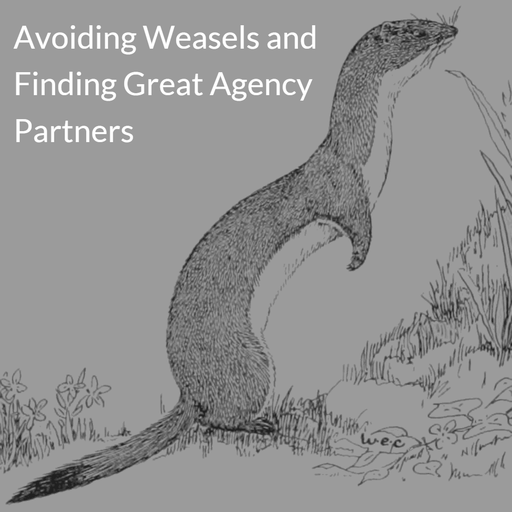This article has been written by Jo Shaer.

Finding Collaborators who Talk & Walk in the same way
It’s actually been quite hard because people pay lip service to qualities that they do not truly espouse. They talk a good talk but they don’t walk the walk! And, to be honest, I was so emotionally scarred by previous experiences that it has taken a while to be in the right frame of mind to address this. Especially as we met further weasels, sponges and benefactors on the journey. There were times when I refused to consider the possibility of working with another company ever again.
However, we then started learning some of the signs so we could recognise the red flags being waved by these “opportunities” and were able to walk away before getting burned.
So, six months – and a lot of experience, reading and thinking – later, I have finally got around to writing this.
The turning point came whilst reading Paul Roetzer’s The Marketing Agency Blueprint. I found a section on what makes a great partner so thought I would use this as my inspiration.
These are the six key areas he highlighted that I felt had the most potential for problems:
1. Paul warns us that every time we outsource, we are putting our brand, reputation and financial success in another agency/person’s hands. That’s a really important thing to remember. If that agency/person doesn’t have the same passion to preserve your good name – or their own – then you are playing with fire.
2. Services must be complementary but without crossover. We have met some lovely people during our travels but there is always the potential for conflict when two agencies who offer the same service work with the same client – even when they are actually being paid to do completely different things – there be Weasels out there!
To avoid client confusion, it is better if there is no crossover. So we prefer to work with web designers who don’t offer inbound or content marketing. Even when the work is complementary, it is important that both businesses sing off exactly the same hymn sheet for the delivery of those services.
Experience has shown that, whilst we normally establish a professional rapport as part of ‘getting to know you’ over a few coffees, it is important to see that the other party has a proper published Company Vision/Mission statement that is rigidly adhered to. It’s a great starting point that they have even thought about this.
3. Pricing – as I also mentioned for Benefactors, if you have one agency selling £1500- 3000 monthly packages whilst the other provider charges £50 per hour, there is always going to be a problem with who is getting the most benefit out of the relationship. Transparency is key. Full disclosure of pricing structure needs to be the order of the day and each party needs to assess what is in it for them and whether they are happy with the deal – from the outset.
For example, my web designer charges his fee and he knows that I will add 25-30% on top for getting and managing the business. He is able to talk to the client direct but never engages in any discussions about pricing. Those all come through me. This is a verbal agreement between the two of us but, to avoid confusion, it might be more prudent to have this in some form of written agreement that both parties acknowledge.
4. Process – If you don’t use the same systems and processes, there is going to be much conflict and confusion. Both service providers need to be organised and agree on a management tool that will keep all the project management details in one place. And they must both be fully familiar with how this tool works. I think a refusal to align in this way is a definite red flag for the future of the partnership. It signifies a rigidity at the outset that doesn’t bode well.
5. Performance – if your partner is not driven to deliver great quality work on budget and on time, you are leaving yourself open to all sorts of problems. Poor quality work on budget on time is not an option. Great quality work that arrives two weeks after you said it would be ready is almost worse.
Do a test run first with something for your own website – something where the delivery is not so crucial – but don’t tell the other party that. Late on the first outing? Again, red flags to be considered before moving forward with an important client.
6. Financial strength – this was something I had not really considered until one of the Sponges we worked with lost a job he had asked us to quote for because he couldn’t prove that he himself was a bona fide company. Sole Trader, no website, no financials posted at Companies’ House.
A few months later, I was asked about my own finances by one individual when being considered for a Joint Venture. I freely gave the information but I did wonder why it was necessary to know. And that same example later declined to work with me because they thought I was too small – even though they themselves were working on their own with no office, no staff and no funding…in fact, another red flag dodged.
What Paul says is that “agencies who struggle financially are often under pressure to keep overhead costs down, which directly impacts the quality of their staff and their capacity to take on new projects.”
Having said that, it needs to be borne in mind that young agencies will be keeping things tight by growing their own staff from apprentices up. There will be churn and it is the job of management to keep high quality as their priority.
So, there you have it. Six factors that I now take into account whenever someone says they want to work with me to service a client.
The Law of Attraction says that if you really think about the people that you want, then the Universe will send them to you. It’s a bit like Inbound really. Decide on your target collaborator and what content you can put out there to attract them to your website.
I want someone who is:
- trustworthy, loyal and passionate about making the Joint Venture work well for BOTH our businesses
- organised with high standards about quality work
- financially stable and either charging the same sort of prices as me or charging sufficiently less that I can make a profit (and is happy for me to do this for bringing in the work as I don’t want to turn into a Benefactor)
Anything you think should be added to this list?
Jo Shaer of Lollipop has been helping UK businesses to improve their online visibility since 2010. She has always advocated using great content to attract website visitors and Inbound Marketing gives a formal strategy to the process.
Find out more at http://www.lollipoplocal.co.uk/inbound-marketing or follow her on Twitter @JoShaer.




